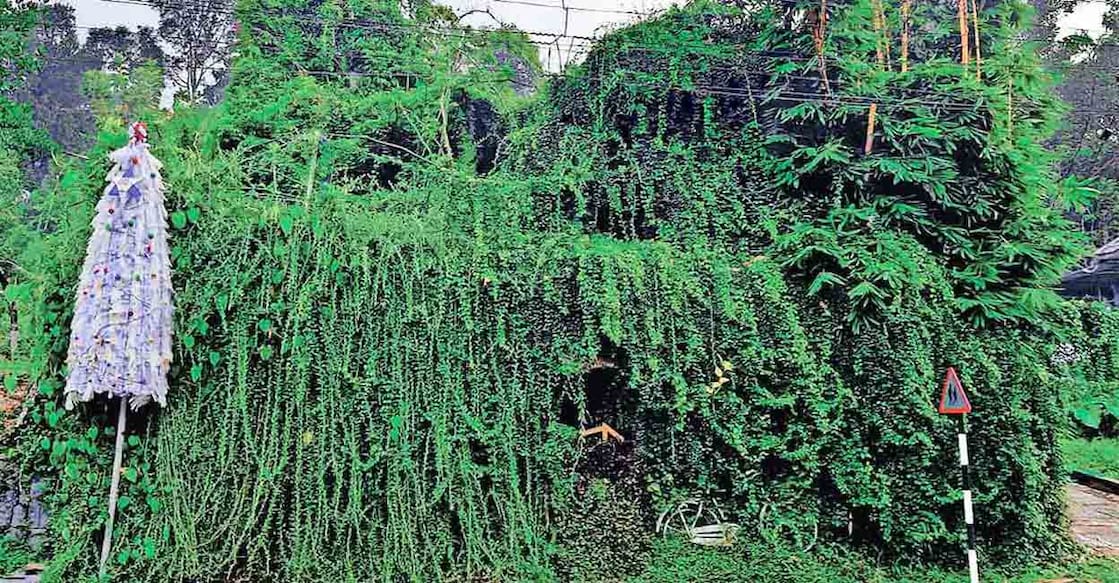Not a forest, this nature home is unique for its extraordinary concept

Mail This Article
When passing this way, one might only notice the dense growth of creepers and nothing more. But knowing that a house is hidden within this wall of vines, and that Prince and Sonia, a teacher couple, live here with their family, is quite surprising. One would wonder if it's even possible to live in such a place.
Ten years ago, deviating from usual tropical home designs, Prince, a sculpture teacher, started planting around his house. The usual concept is to trim and maintain gardens and landscaping meticulously. However, by letting the plants grow without intervention, a small jungle has flourished here.

This jungle encompasses even the compound wall of the house. One must clear away vines to enter. Stepping inside feels like entering a secluded forest. There's no harsh sunlight, only the deep green of the jungle. With abundant plants, trees, flowers, butterflies, and birds, it's like a paradise, cool and refreshing. The inside of the house is no different. The house is located in Vettoor village in Pathanamthitta. Prince has decorated the house with materials he made himself.
Everyone in the family is meticulous in maintaining the house. The highlight of the entire property is the creeper-covered surroundings. Even during the hottest part of the year, even at noon, the temperature inside the house remains a comfortable 26–27 degrees Celsius.

The sheer abundance of plants is evident from the fact that one cannot sit in the living room without touching at least one plant. More than two hundred and fifty different plants are cultivated indoors alone. Only organic fertilizers are used for indoor plants. Artificial lighting is also provided where needed for indoor plant maintenance.
The plants' beauty lies in their natural, untamed growth, free from restrictions and trimming. Prince has adapted the Japanese Kokedama, or moss balls, technology to Kerala's climate and incorporated them into his home décor. This technique allows plants to be arranged in desired shapes without using pots. It uses materials like coir, moss, string, and jute sacks. The installation was showcased as an art exhibition, earning Prince a place in the Limca Book of Records.

Boxes made from marine plywood are used, with pieces of wood collected from forests, cut into various shapes, and used as planters. There's a Buddha statue crafted by Prince himself. Fish caught from the Achankovil and Kallar rivers are kept in an open aquarium. The aquarium is filled with roots and wood that have been submerged in water for years, naturally seasoned through floods and other natural processes, providing a natural habitat for the fish.
A natural question arises: aren't there snakes and other creatures in this house? However, Prince says that in the past 10 years, they haven't encountered a single snake inside or around the house. To keep reptiles away, they occasionally dilute kerosene in water and sprinkle it around, though this is not a regular practice.
The house, measuring 900 square feet, is built on a 5-cent plot. Natural stone is used on the sides of the staircase. A mesh is used, and many plants are grown on top of it. Hanging and non-hanging plants adorn the terrace. Air plants, which need minimal water and sunlight, are also present. They absorb atmospheric moisture and mineral salts; they only need occasional spraying of water.
The rooftop terrace deserves special mention. Prince and his family enjoy their leisure time here, sipping coffee and chatting. While others go to forests and stay in bamboo huts for holidays, they have created that ecosystem in their own home. In Prince's words, it's a 'garden therapy' that keeps mental stress at bay.

